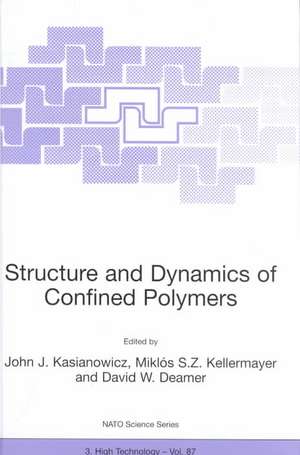Structure and Dynamics of Confined Polymers: Proceedings of the NATO Advanced Research Workshop on Biological, Biophysical & Theoretical Aspects of Polymer Structure and Transport Bikal, Hungary 20–25 June 1999: NATO Science Partnership Subseries: 3, cartea 87
Editat de John J. Kasianowicz, M. Kellermayer, David W. Deameren Limba Engleză Hardback – 31 iul 2002
| Toate formatele și edițiile | Preț | Express |
|---|---|---|
| Paperback (1) | 1224.68 lei 6-8 săpt. | |
| SPRINGER NETHERLANDS – 31 iul 2002 | 1224.68 lei 6-8 săpt. | |
| Hardback (1) | 1228.47 lei 6-8 săpt. | |
| SPRINGER NETHERLANDS – 31 iul 2002 | 1228.47 lei 6-8 săpt. |
Din seria NATO Science Partnership Subseries: 3
- 24%
 Preț: 1567.22 lei
Preț: 1567.22 lei - 18%
 Preț: 1992.08 lei
Preț: 1992.08 lei -
 Preț: 393.13 lei
Preț: 393.13 lei -
 Preț: 390.63 lei
Preț: 390.63 lei - 18%
 Preț: 1849.41 lei
Preț: 1849.41 lei -
 Preț: 407.19 lei
Preț: 407.19 lei - 18%
 Preț: 1228.96 lei
Preț: 1228.96 lei - 18%
 Preț: 1843.73 lei
Preț: 1843.73 lei - 15%
 Preț: 642.51 lei
Preț: 642.51 lei -
 Preț: 402.76 lei
Preț: 402.76 lei - 18%
 Preț: 1829.86 lei
Preț: 1829.86 lei -
 Preț: 379.48 lei
Preț: 379.48 lei - 18%
 Preț: 1224.54 lei
Preț: 1224.54 lei -
 Preț: 401.42 lei
Preț: 401.42 lei - 18%
 Preț: 1841.68 lei
Preț: 1841.68 lei -
 Preț: 391.99 lei
Preț: 391.99 lei - 18%
 Preț: 1234.46 lei
Preț: 1234.46 lei -
 Preț: 405.28 lei
Preț: 405.28 lei -
 Preț: 396.62 lei
Preț: 396.62 lei - 18%
 Preț: 1226.73 lei
Preț: 1226.73 lei - 18%
 Preț: 1233.52 lei
Preț: 1233.52 lei - 18%
 Preț: 1228.62 lei
Preț: 1228.62 lei - 5%
 Preț: 377.52 lei
Preț: 377.52 lei - 18%
 Preț: 1830.49 lei
Preț: 1830.49 lei - 20%
 Preț: 336.21 lei
Preț: 336.21 lei - 18%
 Preț: 1225.48 lei
Preț: 1225.48 lei -
 Preț: 397.38 lei
Preț: 397.38 lei - 18%
 Preț: 1830.65 lei
Preț: 1830.65 lei - 15%
 Preț: 650.55 lei
Preț: 650.55 lei - 5%
 Preț: 1416.66 lei
Preț: 1416.66 lei
Preț: 1228.47 lei
Preț vechi: 1498.13 lei
-18% Nou
Puncte Express: 1843
Preț estimativ în valută:
235.10€ • 244.54$ • 194.09£
235.10€ • 244.54$ • 194.09£
Carte tipărită la comandă
Livrare economică 15-29 aprilie
Preluare comenzi: 021 569.72.76
Specificații
ISBN-13: 9781402006975
ISBN-10: 1402006977
Pagini: 412
Ilustrații: XVII, 390 p.
Dimensiuni: 170 x 244 x 28 mm
Greutate: 0.75 kg
Ediția:2002
Editura: SPRINGER NETHERLANDS
Colecția Springer
Seria NATO Science Partnership Subseries: 3
Locul publicării:Dordrecht, Netherlands
ISBN-10: 1402006977
Pagini: 412
Ilustrații: XVII, 390 p.
Dimensiuni: 170 x 244 x 28 mm
Greutate: 0.75 kg
Ediția:2002
Editura: SPRINGER NETHERLANDS
Colecția Springer
Seria NATO Science Partnership Subseries: 3
Locul publicării:Dordrecht, Netherlands
Public țintă
ResearchCuprins
Profound implications for biophysics of the polymer threading a membrane transition.- Phage DNA transport across membranes.- Translocation of macromolecules across membranes and through aqueous channels: Translocation across membranes.- Protein translocation across the outer membrane of mitochondria: Structure and function of the TOM complex of Neurospora crassa.- Protein translocation channels in mitochondria: TIM & TOM channels.- Sizing channels with neutral polymers.- Dynamic partitioning of neutral polymers into a single ion channel.- Branched polymers inside nanoscale pores.- Physics of DNA threading through a nanometer pore and applications to simultaneous multianalyte sensing.- Mechanism of ionic current blockades during polymer transport through pores of nanometer dimensions.- Using nanopores to discriminate between single molecules of DNA.- Use of a nanoscale pore to read short segments within single polynucleotide molecules.- Polymer dynamics in microporous media.- Entropic barrier theory of polymer translocation.- Polymer translocation through a “complicated” pore.- The polymer barrier crossing problem.- Brownian ratchets and their application to biological transport processes and macromolecular separation.- Composition and structural dynamics of vertebrate striated muscle thick filaments: Role of myosin-associated proteins.- Force-driven folding and unfolding transitions in single Titin molecules: Single polymer strand manipulation.- Dynamics of actin filaments in motility assays: A microscopic model and its numerical simulation.- Conformation-dependent sequence design of copolymers: Example of bio-evolution mimetics approach.- Single molecule nucleic acid analysis by fluorescence flow cytometry.- Fluorescence energy transfer reagents for DNA sequencingand analysis: High-throughput fluorescent DNA sequencing.







